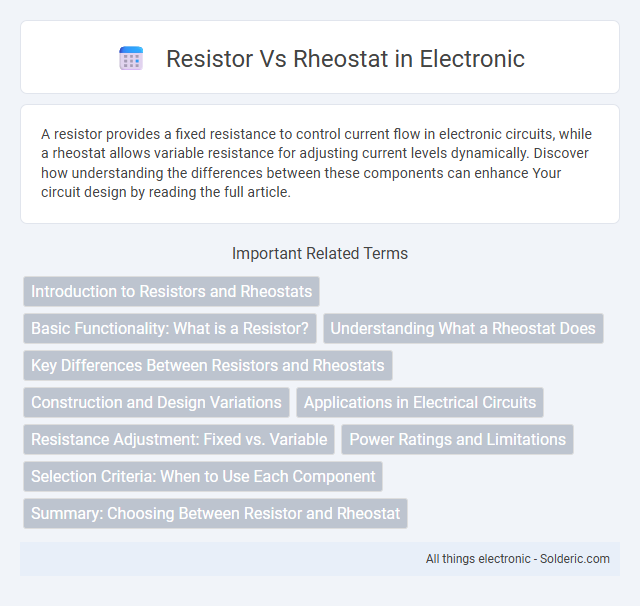A resistor provides a fixed resistance to control current flow in electronic circuits, while a rheostat allows variable resistance for adjusting current levels dynamically. Discover how understanding the differences between these components can enhance Your circuit design by reading the full article.
Comparison Table
| Feature | Resistor | Rheostat |
|---|---|---|
| Function | Limits current and drops voltage | Adjusts current flow manually |
| Type | Fixed resistance | Variable resistance |
| Adjustment | Non-adjustable | Adjustable via slider or knob |
| Symbol | Standard resistor symbol | Variable resistor symbol |
| Application | Voltage termination, current limiting | Brightness control, motor speed control |
| Power Rating | Typically low to moderate | Usually higher to handle variable loads |
| Wiring | Two terminals | Two or three terminals |
| Cost | Lower cost | Higher cost due to adjustability |
Introduction to Resistors and Rheostats
Resistors are passive electrical components designed to limit current flow and drop voltage in circuits, characterized by fixed resistance values. Rheostats are variable resistors used to adjust current manually, controlling circuit parameters like brightness or motor speed. Both components play vital roles in managing resistance but differ in functionality, with resistors offering constant resistance and rheostats providing adjustable resistance.
Basic Functionality: What is a Resistor?
A resistor is an electrical component designed to limit the flow of electric current by providing a fixed resistance measured in ohms. It maintains a consistent resistance value regardless of the applied voltage, enabling precise control of current in circuits. Unlike a rheostat, which allows variable resistance, a resistor's primary function is to provide stable resistance for circuit protection and voltage division.
Understanding What a Rheostat Does
A rheostat is a variable resistor designed to control current by adjusting resistance without interrupting the circuit, making it ideal for dimming lights or regulating motor speed. Unlike a fixed resistor, a rheostat allows you to vary resistance smoothly by sliding a contact over a coil of resistive wire, which changes the amount of current flowing through. Understanding what a rheostat does helps you effectively manage electrical devices by providing precise control over current flow in your circuits.
Key Differences Between Resistors and Rheostats
Resistors and rheostats both control electric current, but resistors provide a fixed resistance while rheostats offer adjustable resistance, allowing you to vary current flow. Resistors are used in circuits for consistent voltage division and current limiting, whereas rheostats enable dynamic control in applications like dimming lights or motor speed adjustment. The construction of resistors involves fixed-value materials, while rheostats incorporate a sliding contact to change resistance continuously.
Construction and Design Variations
Resistors typically consist of a fixed length of resistive material, such as carbon film or metal oxide, enclosed in a rigid protective casing, offering a constant resistance value designed for specific current and voltage ratings. Rheostats are designed with a coil of resistive wire and a movable contact (wiper) that slides along the coil, allowing for adjustable resistance by changing the effective length of the resistive path. Variations in resistors include fixed, variable, and precision types, while rheostats are mainly configured for high-current applications requiring manual adjustment of resistance in circuits such as dimmers and motor controls.
Applications in Electrical Circuits
Resistors are essential components in electrical circuits used for current limiting, voltage division, and signal conditioning due to their fixed resistance values. Rheostats find applications where adjustable resistance is needed, such as controlling motor speed, tuning light intensity, and adjusting sensor sensitivity. By selecting the appropriate device, you can optimize the performance and stability of your electrical systems.
Resistance Adjustment: Fixed vs. Variable
Resistors provide fixed resistance values that remain constant regardless of current or voltage changes, making them ideal for consistent, unaltered circuit performance. Rheostats offer variable resistance through an adjustable sliding contact, allowing precise control over current flow and voltage levels in circuits. This ability to vary resistance makes rheostats essential in applications requiring fine-tuning, such as dimmers and motor speed controls.
Power Ratings and Limitations
Resistors typically have fixed power ratings ranging from 1/8 watt to several watts, designed for precise resistance values in circuits with minimal variation. Rheostats handle higher power ratings, often up to 10 watts or more, enabling adjustable resistance to control current flow and voltage levels dynamically. Limitations include heat dissipation constraints for resistors and mechanical wear over time for rheostats, affecting reliability in high-power applications.
Selection Criteria: When to Use Each Component
Choose a resistor when you need a fixed, precise resistance value for controlling current or voltage in a circuit, ensuring stable performance. Opt for a rheostat when adjustable resistance is required to vary current flow or voltage dynamically, such as in dimmer switches or motor speed controls. Your selection depends on whether fixed or variable resistance best suits the circuit's functional requirements.
Summary: Choosing Between Resistor and Rheostat
Selecting between a resistor and a rheostat depends on the need for fixed versus variable resistance in a circuit. Resistors provide a constant resistance value ideal for precise current control, while rheostats offer adjustable resistance to regulate current flow dynamically. This choice impacts circuit functionality, with rheostats favored in applications requiring real-time tuning and resistors suited for stable, pre-set electrical conditions.
resistor vs rheostat Infographic

 solderic.com
solderic.com